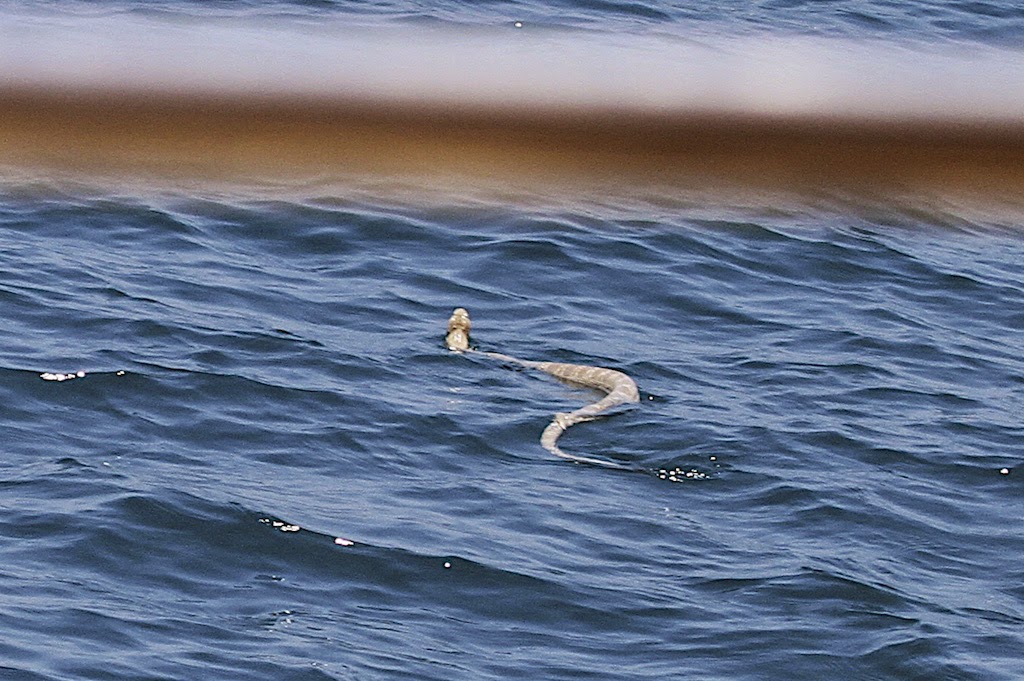 |
| West Island, Ashmore Reef |
Pulling into the anchorage at Ashmore Reef on the third afternoon we were greeted by Brown Booby's and Bridled Terns on the mooring buoy, and then by the customs officers. The customs officers arrive in their high powered tender from their even more high-powered ship and check that all our permits are in order. One of our group commented on their ship and asked how fast it could go, 30 knots? The customs guy just smiled and said "oh, she's fast enough", no secret information from these guys.
 |
| The Customs ship at Ashmore |
 |
| As we approached Ashmore from the south west we were buzzed by the customs patrol |
Once the formalities are completed we are off to West Island for our first vagrant hunt. There are plenty of waders such as Pacific Golden Plover, Sand Plover and Ruddy Turnstone, and our first specialty, a Grey Wagtail. Once off the beach we find our next specialty, an Arctic Warbler. This one bird then became five as we wandered the island on our second day and that is when the fun of an Ashmore trip starts. Are they all Arctic or could any of them be Kamchatka? Each night photos are loaded onto laptops and the field guides come out ..... and the discussions go on for hours. Phyolloscopus warblers are the ultimate id challenge because the variations between them are so small and subtle, the width of a wingbar, the length of the superciliary stripe, the amount of primary projection ..... hours and hours of fun (smile). The expected birds like Island Monarch and Oriental Reed Warbler were missing but we did have Oriental Cuckoos, a stray Peregrine Falcon of the Asian race and some Eastern Yellow Wagtails.
 |
| Grey Wagtail |
 |
| Yellow Wagtail |
 |
| Oriental Cuckoo |
The joy of visiting East Island is that it is the nesting place of literally thousands and thousands of frigatebirds, noddies, terns and boobies. The adults rise in clouds over the island and the young birds scream and yell for food as their parents return from fishing.
 |
| Arctic Warbler |
 |
| Arctic Warbler |
The three days back to Broome can get a bit quiet for birding as the boat crosses shallow coastal waters but it is often a good time for whales and sea snakes. There is a break in the trip though at the Lacepede's, the low islands and shoals about 25 km off the coast just north of Broome. The Lascepede's are another major breeding location for terns, boobies and noddies as well as final chance to find a vagrant before the boat gets back to Broome and we again unload into the tinnies and head for shore, which is a little easier as we no longer have a week's supply of wine and beer with us.
 |
| East Island with young Masked Booby in foreground |
 |
| Juvenile Masked Booby |
 |
| Frigatebirds and terns over East Island |
 |
| Brown Boobies on East Island |
 |
| Indonesian fishing boats at a "fish attracting device" (FAD) |
 |
| A FAD with boobies. Small fish are attracted to the shade and bigger fish come in to feed on them |
 |
| This fish was caught near a FAD but was thrown back. One caught later was turned into delicious sashimi |
 |
| Tuna, either hunting or being hunted |
The final joy of the trip, for me anyway, is to go back to the Roey for the night and to stand under a hot shower with soap, shampoo and conditioner and thoroughly remove a week's accumulation of salt and sun cream. Yes, the boat has showers and we do use them but the Roey has an endless supply of hot water and one does not need to consider rationing the desalinated water on the boat.
 |
| We passed a few small pods of whales on our way back to Broome |
Birding around Broome before and after the trip I saw 75 species without actually chasing anything except for a Little Ringed Plover. On the boat travelling between Broome and Ashmore I saw 26 pelagic species including Tahiti Petrel, Streaked Shearwater, Flesh-footed Shearwater, Bulwer's Petrel, Jouanin's Petrel, Swinhoe's Storm Petrel, Matsudaira's Storm Petrel, Wilson's Storm Petrel, Abbott's Booby and Masked Booby. On the Ashmore Islands I had 59 species including Arctic Warbler, Grey Wagtail, Yellow Wagtail, Peregrine Falcon, Oriental Cuckoo, Horsfield's Cuckoo, Common Redshank, Asian Dowitcher and Oriental Plover.
 |
| Sea snake trying to swallow a large fish |
 |
| Sea snakes were quite common, especially in the more shallow waters between Ashmore and the Lacepede's |
It was a brilliant trip but I think I am getting old, it has taken me over a week to recuperate ... or maybe I shouldn't have got up at 6 am on the last day, birded all day, got on the Broome-Perth-Melbourne flight at 7 pm, flown non-stop through the night and landed in Melb at 6 am. When I booked the flight it seemed like a good idea because I was saving a night's accommodation.
 |
| This Barn Swallow spent the night on board, sleeping on a bar beneath the deck canopy |
 |
| Returning from the Lacepede's. Green Turtle tracks can be seen in the sand. They nest on both the Lacepede's and Ashmore. |
All images & text © Jenny Spry























As usual, great read Jen! Nice boost to your list.
ReplyDelete